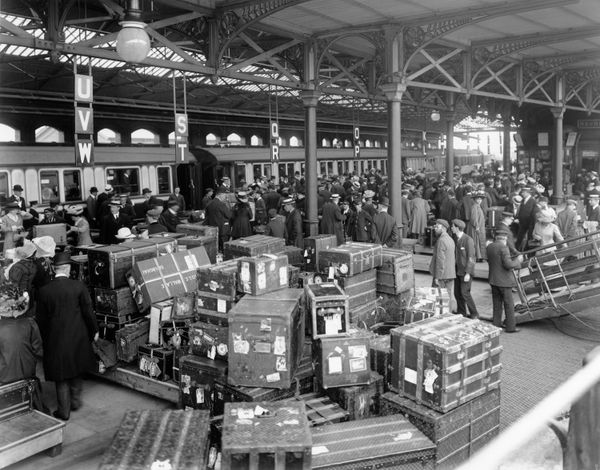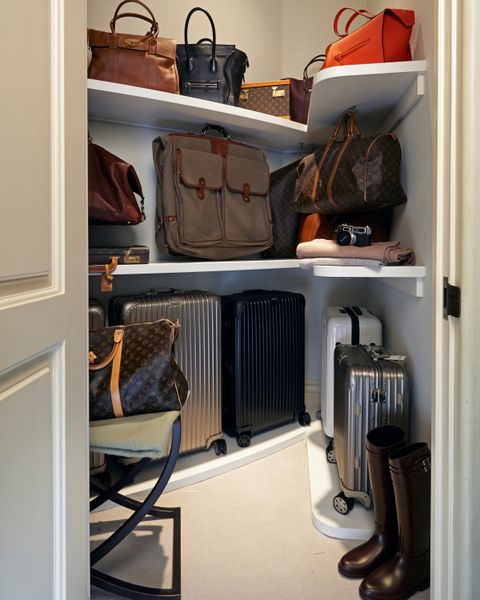As the luxury luggage industry booms, designers are trying tackle an enduring, infuriating problem: storage for storage.
My 450-square-foot apartment’s laundry closet has many uses. It holds cat food, cleaning products, shoes I don’t often wear but might someday, and of course: luggage of various shapes and sizes. Inside my Away roller suitcase goes my carry-on backpack and, inside that, my small Patagonia duffle I’ve had since college. I stack my roller carry-on bag with the broken handle on top of my Away checked bag, and, for the pièce de résistance, miraculously stuff my Osprey hiking backpack inside the carry-on.
The global luggage market is exploding—according to Grand View Research, it was valued around $38.3 billion in 2023 with projected growth to $61.9 billion by 2030—and with rents rising across many U.S. cities, space comes at a premium. We may be buying luggage more now than ever, but most of us lack practical spaces to store our carryalls. In other words, I’m not the only person with a nesting doll of luggage stuck in my laundry closet. In r/homeowners on Reddit, the most common answers to "where do you store your luggage?" are under the bed, nested on a wardrobe shelf, or in a guest room closet—out of sight and out of mind.
In May, TikTok travel tips influencer @rileejsmith, who reviews luggage and shares packing tips, posted a video for her 382,000 followers. It was a tour of her luggage stash and it was much less glamorous than one might expect, given all her #gifted bags. My guess—based on her curated profile and luxury suitcases—was that they would be stored somewhere as aesthetically pleasing, or at least as functional, as her feed. Instead, navigating the dearth of storage in her house, she stacks her suitcases one on top of the other in the crawl space. If the person whose job is luggage can’t come by a better way to store hers, what hope is there for the rest of us?
The evolution of luggage was slow, and then very fast. In the late 19th century, wealthy travelers relied on heavy steamer trunks carried by porters and bellhops. These became so popular that some houses, including the Sears Kit Homes, had small trunk rooms for storing them. In the early 20th century, the first suitcases resembling today’s began to appear; they were lighter, more compact, and easier to carry than the steamer trunk. It was during this era that glamorous hotels began dishing out stick-on luggage labels. Starting in the 1950s, as air travel became increasingly accessible, even lighter carry-on luggage became the norm. Wheels appeared in 1972, and soon after zippers and molded plastics followed. (Today, some of those early vintage pieces have been repurposed into furniture or storage pieces—a reminder of the lost glamour of old-school travel.) Up through the early aughts, squishable soft-sided bags were popular and easier to store, albeit less aesthetically pleasing. By around 2010, the luxurious-looking hardshell was back in earnest, a lighter wheeled version on the vintage trunk.

Circa 1910, passengers (and their luggage) wait to board a boat train at the Holyhead docks in England.
Photo by SSPL/Getty Images
As the luggage industry hits hyperspeed, home design hasn’t quite yet fully caught up. "When doing a new build I’ll ask my client where their luggage is going and they’ll say, ‘great question,’ as if they hadn’t thought about it before," says Lisa Adams, founder of LA Closet Design, a custom closet design company. "We all have luggage, but there’s no dedicated space for luggage." Adams’ solutions have involved pull-down hooks for garment bags, pull-out packing tables, and custom shelves that showcase, rather than conceal, suitcases. For celebrity clients like Ray Romano, she designed a custom luggage closet to showcase Louis Vuitton duffels and Celine bags.

Lisa Adam’s custom luggage closet for actor Ray Romano.
Courtesy of LA Closet Design
Others consult architects: Bade Stageberg Cox Architecture is currently designing an apartment in New York City with not one but two luggage spaces: a cabinet hung from the mezzanine stair, and a walk-in closet. "Every client wants closets for luggage," says Becky Garnett of Garnett.DePasquale, an architecture firm based in New York City and Sag Harbor. "The key is not just the luggage itself," adds Pete DePasquale. "But having the right arrangement to properly review and then easily pack the luggage!" In other words, investing in smarter, sleeker, or more compact luggage doesn’t solve the problem of where to put it all.
A need for clever storage solutions isn’t limited to the U.S. In Hong Kong, one of the densest cities in the world where living space is both scarce and expensive, architect Patrick Lam, who runs Sim-Plex Design Studio, outfitted a 484-square-foot apartment with operable floor panels. Designed for a couple who both travel extensively for work (she’s a flight attendant and he works in mainland China), the apartment floor lifts up to reveal suitcases and miscellaneous items like their son’s toys.

Architect Patrick Lam outfitted a 484-square-foot apartment with operable floor panels that lift up to store luggage.
Courtesy of Patrick Lam
See the full story on Dwell.com: Where Do We Put All Our (Literal) Baggage?
Read More
By: Grace Bernard
Title: Where Do We Put All Our (Literal) Baggage?
Sourced From: www.dwell.com/article/where-do-i-store-my-luggage-bbbe1ebf
Published Date: Wed, 06 Aug 2025 20:44:14 GMT
.png)





